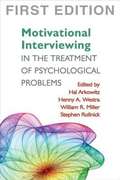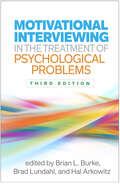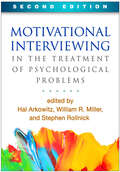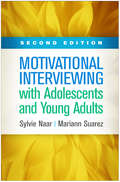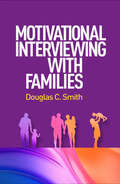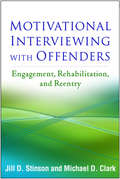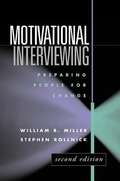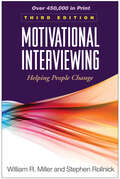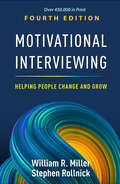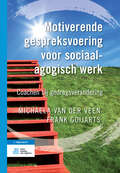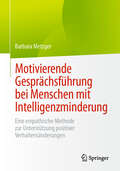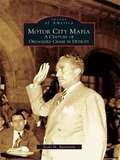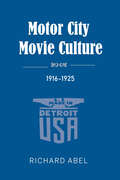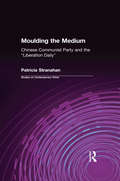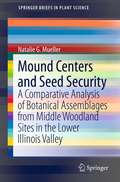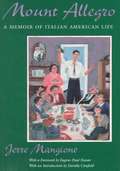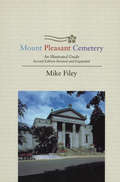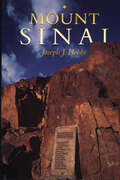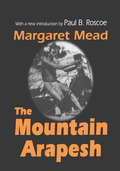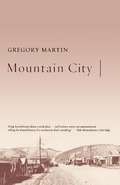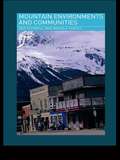- Table View
- List View
Motivational Interviewing in the Treatment of Psychological Problems
by Henny Westra Hal ArkowitzSince the publication of Miller and Rollnick's classic Motivational Interviewing, MI has become hugely popular as a tool for facilitating many different kinds of positive behavior change. MI is increasingly being used to help individuals mobilize their energy, commitment, and personal resources for addressing a wide range of mental health concerns. This cutting-edge book brings together leading experts to describe MI applications in the treatment of anxiety, depression, PTSD, suicidal behavior, obsessive-compulsive disorder, eating disorders, gambling addictions, schizophrenia, and dual diagnoses. Also addressed are MI approaches in the criminal justice system. Each chapter provides a concise overview of the disorder or population under discussion; describes how MI has been integrated with standard treatment approaches; illustrates the nuts and bolts of intervention, using vivid clinical examples; and reviews the empirical evidence base.
Motivational Interviewing in the Treatment of Psychological Problems (Applications of Motivational Interviewing Series)
by Hal Arkowitz Brian L. Burke Brad LundahlWith 75% new material, the fully revised third edition of this clinical reference and text describes ways to integrate motivational interviewing (MI) into evidence-based psychotherapy and counseling. Readers learn how MI concepts and tools can enhance their foundational skills as helpers--and can be tailored for clients with depression, anxiety disorders, addictions, posttraumatic stress disorder, and other frequently encountered problems. Chapters are grounded in research on what works for particular disorders. Vivid case examples illustrate the role that MI can play in helping clients at any stage of treatment to resolve ambivalence and mobilize their energy, commitment, and personal resources for change. New to This Edition *Chapters on culturally responsive MI, trauma-informed practices, and MI in child welfare. *Chapters on treating chronic pain and serious mental illness. *Key developments in MI, as well as current psychological research. *Extensive annotated sample dialogues throughout the chapters. This book is in the Applications of Motivational Interviewing series, edited by Stephen Rollnick, William R. Miller, and Theresa B. Moyers.
Motivational Interviewing in the Treatment of Psychological Problems, Second Edition (Applications of Motivational Interviewing)
by Stephen Rollnick William R. Miller Hal ArkowitzThis authoritative guide has given tens of thousands of clinicians proven tools for helping clients resolve ambivalence and mobilize their energy, commitment, and personal resources for change. Leading experts describe ways to combine motivational interviewing (MI) with other treatments for a wide range of psychological problems, including depression, anxiety disorders, eating disorders, posttraumatic stress disorder, and others. Chapters illustrate the nuts and bolts of intervention, using vivid clinical examples, and review the empirical evidence base. Contributors show how to tailor MI to each population's needs, whether used as a pretreatment or throughout the course of therapy. New to This Edition *Many new authors; extensively revised with the latest theory, practices, and research. *Chapters on domestic violence, addictions, and smoking cessation with adolescents. *Chapter on transdiagnostic treatment.
Motivational Interviewing with Adolescents and Young Adults
by Sylvie Naar-King Mariann SuarezThis pragmatic guide spells out how to use motivational interviewing (MI) to have productive conversations about behavior change with adolescents and young adults in any clinical context. Filled with vivid examples, sample dialogues, and "dos and don'ts," the book shows how conducting MI from a developmentally informed standpoint can help practitioners quickly build rapport with young patients, enhance their motivation to make healthy changes, and overcome ambivalence. Experts on specific adolescent problems describe MI applications in such key areas as substance abuse, smoking, sexual risk taking, eating disorders and obesity, chronic illness management, and externalizing and internalizing behavior problems.
Motivational Interviewing with Adolescents and Young Adults, Second Edition (Applications of Motivational Interviewing)
by Mariann Suarez Sylvie NaarThe significantly revised second edition of this unique practitioner guide features 65% new material and a new organizing structure. The authors show how to use motivational interviewing (MI) to have productive conversations about behavior change with adolescents and young adults in any clinical context. Noted for its clarity, the book includes extended case examples, sample dialogues, quick-reference tables, and "dos and don'ts." It provides vital tools for helping young people open up about their struggles, explore alternatives, and make healthier choices around such concerns as substance use, smoking, anxiety, medication adherence, and obesity. New to This Edition *More integrative and cohesive: every chapter weaves in diverse clinical issues, replacing the prior edition's population-specific chapters. *Chapters on MI in groups and involving caregivers in treatment. *Restructured around the current four-process model of MI, and proposes maintenance of change as a fifth process. *Incorporates the rapidly growing research base on MI with youth. *Reflects the ongoing refinement of the authors' training approach; includes skill-building activities at the end of each chapter. This book is in the Applications of Motivational Interviewing series, edited by Stephen Rollnick, William R. Miller, and Theresa B. Moyers.
Motivational Interviewing with Families (Applications of Motivational Interviewing Series)
by Douglas C. SmithWhile motivational interviewing (MI) was developed as a counseling approach for individuals, it also has tremendous utility for helping families change and grow. This book offers the first comprehensive guide to adapting MI skills to engage families--including reluctant members--in therapy and mobilize family-level change processes. Extensive annotated sample dialogues show how MI can be integrated with any therapy approach for families struggling with mental health problems, addictions, relationship challenges, difficult life transitions, or other concerns. Special features include boxed sidebars, reflection questions, and practice exercises. The Appendix and companion website provide additional helpful resources for using MI with families. This book is in the Applications of Motivational Interviewing series, edited by Stephen Rollnick, William R. Miller, and Theresa B. Moyers.
Motivational Interviewing with Offenders: Engagement, Rehabilitation, and Reentry
by Jill D. Stinson Michael D. ClarkFrom experts on working with court-mandated populations, this book shows how motivational interviewing (MI) can help offenders move beyond resistance or superficial compliance and achieve meaningful behavior change. Using this evidence-based approach promotes successful rehabilitation and reentry by drawing on clients' values, goals, and strengths--not simply telling them what to do. The authors clearly describe the core techniques of MI and bring them to life with examples and sample dialogues from a range of criminal justice and forensic settings. Of crucial importance, the book addresses MI implementation in real-world offender service systems, including practical strategies for overcoming obstacles. This book is in the Applications of Motivational Interviewing series.
Motivational Interviewing, Second Edition
by Stephen Rollnick William MillerThis bestselling work has introduced hundreds of thousands of professionals and students to motivational interviewing (MI), a proven approach to helping people overcome ambivalence that gets in the way of change. William R. Miller and Stephen Rollnick explain current thinking on the process of behavior change, present the principles of MI, and provide detailed guidelines for putting it into practice. Case examples illustrate key points and demonstrate the benefits of MI in addictions treatment and other clinical contexts. The authors also discuss the process of learning MI. The volume's final section brings together an array of leading MI practitioners to present their work in diverse settings. New to This Edition Expanded 11 new chapters. Incorporates the growing body of outcome research. More applications of MI within and beyond the addictions field. Coverage of MI and the stages-of-change model; applications in medical, public health, and criminal justice contexts; and the use of MI with groups, couples, and adolescents.
Motivational Interviewing, Third Edition: Helping People Change (Applications of Motivational Interviewing)
by Stephen Rollnick William R. MillerThis bestselling work for professionals and students is the authoritative presentation of motivational interviewing (MI), the powerful approach to facilitating change. The book elucidates the four processes of MI, engaging, focusing, evoking, and planning and vividly demonstrates what they look like in action. A wealth of vignettes and interview examples illustrate the "dos and don'ts" of successful implementation in diverse contexts. Highly accessible, the book is infused with respect and compassion for clients. The companion Web page provides additional helpful resources, including reflection questions, an extended bibliography, and annotated case material. This book is in the Applications of Motivational Interviewing series. New to This Edition Reflects major advances in understanding and teaching MI. Fully restructured around the new four-process model. Additional case examples and counseling situations. Reviews the growing evidence base and covers ways to assess MI fidelity. Pedagogical Features Include Online reflection questions and annotated cases, ideal for classroom discussion. Key points at the end of each chapter. Engaging boxes with special topics and personal reflections. Extended bibliography and quick-reference glossary.
Motivational Interviewing: Helping People Change and Grow (Applications of Motivational Interviewing)
by Stephen Rollnick William R. MillerNow in a fully rewritten fourth edition, this is the authoritative presentation of motivational interviewing (MI), the powerful approach to facilitating change. It has been updated and streamlined to be even more user-friendly as a practitioner guide and course text. MI originators William R. Miller and Stephen Rollnick elucidate the four tasks of MI--engaging, focusing, evoking, and planning--and vividly demonstrate what they look like in action. A wealth of vignettes and interview examples illustrate the dos and don'ts of successful implementation in diverse contexts. The book reviews the evidence base for the approach and covers ways to assess the quality of MI. The companion website provides reflection questions, annotated case material, and additional helpful resources. New to This Edition *Most of the book is entirely new. *Addresses the breadth of MI applications not only in counseling and psychotherapy, but also in health care, education, coaching, management, and other contexts. *Discusses delivering MI remotely, simple versus complex affirmations, strategic use of directional questions, ethical considerations, and other new or expanded topics. *Increased emphasis on using MI throughout a client's process of change and growth, not just in the preparatory stage. Pedagogical Features *New or updated online materials, including reflection questions and annotated cases. *Key points at the end of each chapter. *"Personal Perspective" and "For Therapists" boxes in every chapter. *Extensive glossary. *New self-assessment tool that targets the component skills of MI. This book is in the Applications of Motivational Interviewing series, edited by Stephen Rollnick, William R. Miller, and Theresa B. Moyers.
Motive für ein Freiwilliges Soziales Jahr aus biografischer Perspektive (Kasseler Edition Soziale Arbeit #25)
by Tim WersigDer Band untersucht die Motivbildung für ein Freiwilliges Soziales Jahr (FSJ) bei jungen Erwachsenen und Jugendlichen. Im Fokus der empirischen Auseinandersetzung stehen Lebensgeschichten und biografische Erzählungen derer, die ein Freiwilliges Soziales Jahr planen. Dabei wird untersucht, inwieweit explizite und implizite Motive für die Teilnahme am FSJ mit dem individuellen biografischen Erleben und Geschehen der Freiwilligen verknüpft sind. Zugleich wird analysiert, inwiefern unterschiedliche lebensgeschichtliche als auch lebensverlaufsbezogene Aspekte und Ereignisse sowie Sozialisationsinstanzen für die Motivbildung und Entscheidung für ein FSJ bedeutend erscheinen.
Motiverende gespreksvoering voor sociaalagogisch werk: Coachen bij gedragsverandering
by Michaela Veen Frank GoijartsHoe bouw je een werkbare relatie op? Hoe breng je cliënten zover dat ze er zelf voor kiezen hun gedrag te veranderen? Hoe zorg je ervoor dat ze het gevoel hebben stappen te kunnen zetten op weg naar kansrijker gedrag dat (uiteindelijk) hun eigen welzijn ten goede komt? Hoe bereik je dat het niet alleen bij plannen blijft, maar dat ze de ingezette verandering ook volhouden? Motiverende gespreksvoering voor sociaalagogisch werk biedt een toegankelijke en praktische vertaling van recente inzichten over het beïnvloeden van motivatie en gedrag naar de praktijk van het sociaalagogisch werkveld. 'Motivational Interviewing' zoals ontwikkeld door Miller & Rollnick vormt daarbij de belangrijkste leidraad. Dit boek biedt een gedegen theoretisch begrip van de diverse concepten die aan de gespreksmethode ten grondslag liggen, maar is vooral praktijkgericht. De verschillende stappen in de motiverende benadering worden duidelijk uiteengezet en toegelicht. Er zijn cases en voorbeelddialogen met een toelichting. Op de begeleidende website is aanvullend materiaal beschikbaar in de vorm van reflectievragen, verschillende videovoorbeelden uit de diverse werkvelden, aanvullende dialogen, opdrachten en toetsvragen.
Motivierende Gesprächsführung bei Menschen mit Intelligenzminderung: Eine empathische Methode zur Unterstützung positiver Verhaltensänderungen
by Barbara MetzgerMenschen mit Intelligenzminderung stehen häufig vor besonderen Herausforderungen – sei es in ihrer Lebensgestaltung, in der Kommunikation oder im Umgang mit gesundheitlichen und sozialen Schwierigkeiten. Zugleich fehlt es häufig an geeigneten beraterischen und therapeutischen Konzepten, die auf ihre besonderen Bedürfnisse ausgerichtet sind. Dieses Fachbuch zeigt, wie die bewährte Methode der Motivierenden Gesprächsführung (Motivational Interviewing) speziell für diesen Personenkreis angepasst werden kann. Schritt für Schritt wird beschrieben, wie durch Empathie, Akzeptanz und gezielte Kommunikationsstrategien Veränderungsmotivation geweckt und nachhaltige Fortschritte erreicht werden können – und das ohne Druck und Zwang. Mit anschaulichen Ablaufplänen, Fallbeispielen, praxiserprobten Gesprächsmethoden und wissenschaftlich fundierten Hintergrundinformationen richtet sich dieses Buch an Fachkräfte, Angehörige und alle, die Menschen mit Intelligenzminderung auf ihrem Weg zu mehr Selbstbestimmung und Lebensqualität begleiten möchten. Ein wertvoller Leitfaden für eine respektvolle und erfolgreiche Unterstützung positiver Veränderungen.
Motor City Mafia: A Century of Organized Crime in Detroit (Images of America)
by Scott M. BurnsteinMotor City Mafia: A Century of Organized Crime in Detroit chronicles the storied and hallowed gangland history of the notorious Detroit underworld. Scott M. Burnstein takes the reader inside the belly of the beast, tracking the bloodshed, exploits, and leadership of the southeast Michigan crime syndicate as never before seen in print. Through a stunning array of rare archival photographs and images, Motor City Mafia captures Detroit's most infamous past, from its inception in the early part of the 20th century, through the years when the iconic Purple Gang ruled the city's streets during Prohibition, through the 1930s and the formation of the local Italian mafia, and the Detroit crime family's glory days in the 1950s, 1960s, and 1970s, all the way to the downfall of the area's mob reign in the 1980s and 1990s.
Motor City Movie Culture, 1916–1925
by Richard AbelA study of how the film industry came to flourish in Detroit in the early years as locals were lured into the new picture theaters. Motor City Movie Culture, 1916–1925 is a broad textured look at Hollywood coming of age in a city with a burgeoning population and complex demographics. Richard Abel investigates the role of local Detroit organizations in producing, distributing, exhibiting, and publicizing films in an effort to make moviegoing part of everyday life. Tapping a wealth of primary source material—from newspapers, spatiotemporal maps, and city directories to rare trade journals, theater programs, and local newsreels—Abel shows how entrepreneurs worked to lure moviegoers from Detroit&’s diverse ethnic neighborhoods into the theaters. Covering topics such as distribution, programming practices, nonfiction film, and movie coverage in local newspapers, with entr&’actes that dive deeper into the roles of key individuals and organizations, this book examines how efforts in regional metropolitan cities like Detroit worked alongside California studios and New York head offices to bolster a mass culture of moviegoing in the United States.
Motor City Movie Culture, 1916–1925
by Richard AbelA study of how the film industry came to flourish in Detroit in the early years as locals were lured into the new picture theaters. Motor City Movie Culture, 1916–1925 is a broad textured look at Hollywood coming of age in a city with a burgeoning population and complex demographics. Richard Abel investigates the role of local Detroit organizations in producing, distributing, exhibiting, and publicizing films in an effort to make moviegoing part of everyday life. Tapping a wealth of primary source material—from newspapers, spatiotemporal maps, and city directories to rare trade journals, theater programs, and local newsreels—Abel shows how entrepreneurs worked to lure moviegoers from Detroit&’s diverse ethnic neighborhoods into the theaters. Covering topics such as distribution, programming practices, nonfiction film, and movie coverage in local newspapers, with entr&’actes that dive deeper into the roles of key individuals and organizations, this book examines how efforts in regional metropolitan cities like Detroit worked alongside California studios and New York head offices to bolster a mass culture of moviegoing in the United States.
Moulding the Medium: Chinese Communist Party and the "Liberation Daily"
by Patricia StranahanIntroduces to researchers the content of the Chinese Communist Party's first official newspaper, the Liberation daily, and examines its role in the acceptance and implementation of the party's goals during its span from May 1941 to March 1947. Includes chronological and topical outlines of the paper
Mound Centers and Seed Security
by Natalie G. MuellerAt Middle Woodland sites in the eastern United States, excavations have uncovered naturalistic art worked on exotic materials from points as distant Wyoming, Ontario, and the Gulf Coast, revealing a network of ritual exchange referred to as the Hopewell phenomenon. Simultaneously, Middle Woodland societies developed the earliest agricultural system in eastern North American using now-extinct native cultivars. Mound Centers and Seed Security: A Comparative Analysis of Botanical Assemblages from Middle Woodland Sites in the Lower Illinois Valley integrates an interpretation of these two historical trends. Unlike most journal articles on related subjects, the volume includes a lengthy review of literature on both Hopewell studies and Middle Woodland agriculture, making it a useful resource for researchers starting out in either field. Synthesizing both original research and research reported in archaeological "grey literature", Mound Centers and Seed Security: A Comparative Analysis of Botanical Assemblages from Middle Woodland Sites in the Lower Illinois Valley is a valuable tool for researchers and teachers alike.
Mount Allegro: A Memoir of Italian American Life
by Jerre MangioneMount Allegro is an extraordinary memoir, a celebration of Sicilian life, an engaging sociological portrait, a moving reminiscence of a fledgling writer's escape from the restrictive culture in which he grew up. Jerre Mangione's autobiographical chronicle of his youth in a Sicilian Community in Rochester is one of the truly enduring books about the immigrant experience in this country. Family squabbles, soul-nourishing food, and the casting of evil eyes are only some of the ingredients of this richly textured book, although they must all take second place to its unforgettable characters. As Eugene Paul Nassar writes in the book's Foreword, "Mount Allegro . . . gave a literary visibility and identity, amiable and appealing, to a poorly understood ethnic group in America, and did so at a very high level of artistry. " Book jacket.
Mount Pleasant Cemetery: Second Edition, Revised and Expanded
by Mike FileyEstablished in 1876, Mount Pleasant Cemetery has a rich and textured history. It is the keeper of thousands of stories, each of which has contributed to the history of our city, province, and country.Many of Canada’s most beloved figures rest there - William Lyon Mackenzie King, Foster Hewitt, Glenn Gould, and Timothy Eaton are just a few. Other, less known historical figures are buried there also - the first Canadian soldier killed in First World War and victims of the 1949 Noronic disaster.Along with a fascinating account of the cemetery’s history, this illustrated guide includes descriptions of the remarkable monuments and the beautiful horticultural features. Accompanying maps detailing their locations make this book a perfect companion for a walking tour through the grounds.
Mount Sinai
by Joseph J. HobbsAmid the high mountains of Egypt's southern Sinai Peninsula stands Jebel Musa, "Mount Moses," revered by most Christians and Muslims as Mount Sinai. (Jewish tradition holds that Mount Sinai should remain terra incognita, unlocated, and does not associate it with this mountain.) In this fascinating study, Joseph Hobbs draws on geography and archaeology, Biblical and Quranic accounts, and the experiences of people ranging from Christian monks to Bedouin shepherds to casual tourists to explore why this mountain came to be revered as a sacred place and how that very perception now threatens its fragile ecology and its sense of holy solitude. After discussing the physical characteristics of Jebel Musa and the debate that selected it as the most probable Mount Sinai, Hobbs fully describes all Christian and Muslim sacred sites around the mountain. He views Mount Sinai from the perspectives of the centuries-long inhabitants of the region—the monks of the Monastery of St. Katherine and the Jabaliya Bedouins—and of tourists and pilgrims, from medieval Europeans to modern travelers dispirited by Western industrialization. Hobbs concludes his account with the recent international debate over whether to build a cable car on Mount Sinai and with an unflinching description of the negative impact of tourism on the delicate desert environment. His book raises important, troubling questions for everyone concerned about the fate of the earth's wild and sacred places.
Mountain Arapesh: Socio-economic Life And Diary Of Events In Alitoa
by Margaret MeadFor approximately eight months during 1931-1932, anthropologist Margaret Mead lived with and studied the Mountain Arapesh-a segment of the population of the East Sepik Province, Papua New Guinea. She found a culture based on simplicity, sensitivity, and cooperation. In contrast to the aggressive Arapesh who lived on the plains, both the men and the women of the mountain settlements were found to be, in Mead's word, maternal. The Mountain Arapesh exhibited qualities that many might consider feminine: they were, in general, passive, affectionate, and peaceloving. Though Mead partially explains the male's "femininity" as being due to the type of nourishment available to the Arapesh, she maintains social conditioning to be a factor in the type of lifestyle led by both sexes. Mead's study encapsulates all aspects of the Arapesh culture. She discusses betrothal and marriage customs, sexuality, gender roles, diet, religion, arts, agriculture, and rites of passage. In possibly a portent for the breakdown of traditional roles and beliefs in the latter part of the twentieth century, Mead discusses the purpose of rites of passage in maintaining societal values and social control. Mead also discovered that both male and female parents took an active role in raising their children. Furthermore, it was found that there were few conflicts over property: the Arapesh, having no concept of land ownership, maintained a peaceful existence with each other. In his new introduction to The Mountain Arapesh, Paul B. Roscoe assesses the importance of Mead's work in light of modern anthropological and ethnographic research, as well as how it fits into her own canon of writings. Roscoe discusses findings he culled from a trip to Papua New Guinea in 1991 to clarify some ambiguities in Mead's work. His travels also served to help reconstruct what had happened to the Arapesh since Mead's historic visit in the early 1930s.
Mountain City
by Gregory MartinThis book offers a very honest and open description of the people and things that makes this small Mountain town live and breathe. It brings to life the people who live there, work there and die there. An excellent insight on humanity.
Mountain Environments (Ecogeography Series)
by Romola ParishThis book breaks the ground in Geographical texts by transcending a strictly regional or topical focus. It presents the opportunities and constraints that mountains and their resources offer to local and global populations; the impacts of environmental and economic change, development and globalisation on mountain environments. Part of the Ecogeography series edited by Richard Hugget
Mountain Environments and Communities (Routledge Physical Environment Ser.)
by Romola Parish Don FunnellMountain Environments and Communities explains the background physical environment and then explores the environmental and social dimensions of mountain regions.This critical review of the concepts currently employed in mountain research, draws upon a wide range of examples from developed and developing countries. The dynamics of mountain life are described through both historical accounts of village-based systems and examples of the contemporary impact of global capital and sustainable development strategies.
